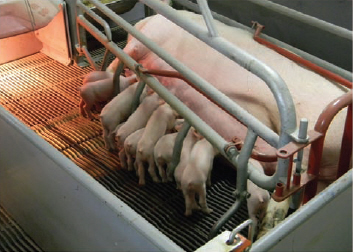



Dietary Omega-6 to Omega-3 Ratio Impacts Nursery Pigs
Altering the omega-6 (n-6) to omega-3 (n-3) ratio, not the absolute intake amount, improved nursery pig performance and protein deposition in two experiments at the Prairie Swine Research Centre, reported in its Annual Research Report 2013-14.Summary
Results from these experiments indicate that altering the n-6 to n-3 fatty acid (FA) ratio can improve nursery pig performance, and protein deposition, potentially by diverting nutrients away from an unnecessary inflammatory response.

Additionally, the researchers found no effects on piglet performance or health by altering the amount without changing the FA ratio.
Results from this project indicate that in order to observe benefits of feeding n-3 FAs to nursery pigs, it is more important to ensure the ratio of n-3s relative to n-6s are altered as opposed to simply increasing the amount without changing the ratio.
Introduction

Weaning is a stressful time in a piglet’s life. They undergo social, environmental and nutritional stressors at a time when their immune system is not fully developed. Th is can precipitate the ‘post-weaning growth lag’, which is characterised by animals going off feed, reduced or negative growth rates and increased susceptibility to pathogens.
These stresses can trigger an inflammatory reaction in some piglets. Although a certain degree of an inflammatory response is beneficial, an over-production of inflammatory cells may become detrimental to the animals, leading to reduced muscle synthesis or even muscle degradation, characteristic of the post-weaning growth lag.
Over the years, there has been a high degree of interest in nutritional modulation aimed at helping piglets cope during this time period.
Omega-3 fatty acids have many potential health benefits, including anti-inflammatory properties. Previous research however, has shown conflicting data in terms of inflammatory responses and animal performance when n-3s are fed.
The authors hypothesised that different concentrations of n-6 fatty acids in the diet among the different studies may explain some of these contradictions. In fact, it has been suggested that it may be more beneficial to reduce the dietary n-6 to n-3 FA ratio when feeding pigs than to simply increase the n-3 amount, in order to see benefits.
This project was designed to determine if whether altering the dietary n-3 to n-6 ratio or changing the absolute intake amount of n-3 was more important for impacting nursery pig health and performance.
To achieve this, the authors conducted two experiments. In the first, the aim was to characterise how the FA ratio and intake would affect the growth and performance of nursery pigs, including whole body FA and protein deposition. Secondly, they wanted to look specifically at how the omega-3 ratio and intake amounts affect the piglets’ ability to mount an acute inflammatory response post-weaning.

Experimental Procedure
A total of five dietary treatments were used for each trial.
Diets consisted of:
- a control (Con; 10:1 n-6:n-3, 3.5 per cent total fat, tallow-based)
- three diets with 3.5 per cent fat (plant-based) and n-6:n-3 ratios of 10:1, 5:1 or 1:1 (3.5/10, 3.5/5 and 3.5/1, respectively), and
- a 10:1 ratio diet with 5.0 per cent total fat (5/10).
This design allowed the comparison of increasing n-3 intake at a constant ratio (10:1 ratio, 3.5 versus 5.0 per cent fat) and decreasing ratio at a constant n-3 intake (3.5 per cent fat, 10:1, 5:1 and 1:1 ratios).
Experiment 1: Nursery Pig Performance
Newly weaned pigs (n=300; 26 ± 2 days of age) were housed in groups of five per pen.
Pens were assigned to one of the five diets described above. Pigs and feeders were weighed weekly for four weeks. Additionally, six pigs were slaughtered on day 0 (initial slaughter group, ISG) and six pigs per diet were slaughtered on day 28, allowing the calculation of whole body protein, fat and water deposition rates throughout the course of the four-week trial.
Experiment 2: Inflammatory Challenge
Individually housed, newly weaned pigs (26 ± 2 days of age; n=100) were assigned to one of the five diets and one of two inflammatory challenge groups arranged as a 5×2 factorial with repeated measures.
Challenge groups consisted of a saline or LPS (15μg per kg bodyweight E. coli lipopolysaccharide) injection.
Pigs were fed their assigned diets for 22 days prior to the 24 hours inflammatory challenge on day 23. Rectal temperatures were measured hourly for the first six hours, then at 12 and 24 hours post-injection.
Blood samples were collected at 0, 2, 6 and 12 hours post-injection for analysis of certain inflammatory proteins (interleukin (IL)-1β, IL-6, IL-8 and tumor necrosis factor (TNF)-α) as well as blood urea nitrogen (BUN) as an indicator of muscle catabolism.
Results and Discussion
During the nursery performance study (Table 1), increasing n-3 amount (constant 10:1 ratio), did not affect average daily feed intake (ADFI) or average daily gain (ADG) but when the n-6:n-3 ratio decreased (constant total fat) from 10:1 to 1:1, ADFI improved (0.93 versus 1.13g per day; P=0.02) during days 21 to 28 post-weaning.
Pigs consuming the 3.5/5 diet tended to have increased protein (82.5 versus 71.1 versus 74.2g per day; P=0.07) and water (342.1 versus 301.0 versus 313.0g per day; P=0.06) deposition rates relative to those consuming the 3.5/10 or 3.5/1 diets.
| Table 1. Effects of altering the dietary n-3 fatty acid amount or ratio on nursery pig performance and carcass composition |
|||||||
| Dietary treatment | Effect of ratio 2 | ||||||
|---|---|---|---|---|---|---|---|
| A | B | C | D | E | Diet B vs. D vs. E) | ||
| n-6:n-3 ratio | 10:1s | 10:1 | 10:1 | 5:1 | 1:1 | ||
| Fat % | 3.5 | 3.5 | 5.0 | 3.5 | 3.5 | SEM | P-value |
| Average daily feed intake (kg/day) | |||||||
| - days 21-28 | 0.97 a | 0.95 a | 0.93 a | 0.97 a | 1.13 b | 0.042 | 0.02 |
| - days 7-28 | 0.68 | 0.67 | 0.66 | 0.69 | 0.78 | 0.031 | 0.08 |
| - days 0-28 | 0.56 | 0.55 | 0.54 | 0.56 | 0.63 | 0.025 | 0.11 |
| Average daily gain (kg/day) | |||||||
| - days 21-28 | 0.97 | 0.97 | 0.95 | 0.94 | 1.01 | 0.031 | 0.59 |
| - days 7-28 | 0.48 | 0.49 | 0.48 | 0.49 | 0.51 | 0.016 | 0.65 |
| - days 0-28 | 0.39 | 0.40 | 0.39 | 0.40 | 0.42 | 0.015 | 0.58 |
| Gain:feed ratio | |||||||
| - days 21-28 | 1.00 | 1.02 | 1.03 | 0.98 | 0.92 | 0.032 | 0.18 |
| - days 7-28 | 0.71 | 0.73 | 0.75 | 0.72 | 0.68 | 0.023 | 0.38 |
| - days 0-28 | 0.70 | 0.73 | 0.74 | 0.71 | 0.69 | 0.024 | 0.64 |
| Deposition rate (g/day) | |||||||
| - Protein | 78.45 ab | 71.07 bc | 69.27 c | 82.45 a | 74.24 abc | 3.241 | 0.07 |
| -Lipid | 35.62 | 31.88 | 34.03 | 31.37 | 30.29 | 2.800 | 0.92 |
| -Water | 328.72 ab | 300.95 bc | 298.61 c | 342.05 a | 313.01 bc | 11.520 | 0.06 |
| 1 10:1s diet contains a saturated fat source whereas all other diets contain unsaturated fat sources 2 Effect of altering the n-3 amount (diet B vs C) was non-significant for all parameters |
|||||||
Lipid deposition was unaffected by treatment (P>0.10).
These results indicate that altering the n-6:n-3 ratio is more beneficial than altering the intake amount of n-3s in terms of eliciting positive responses such as increased feed intake and protein deposition in nursery pigs when using plant based n-3 FAs.
In the inflammatory challenge experiment, average daily gain and average daily feed intake from days 0 to 22 or just during the challenge period were unaffected by diet (P>0.05).
During the challenge, LPS pigs had lower (P<0.01) average daily feed intake (0.93 versus 0.40kg, saline versus LPS) and average daily gain (+0.44kg versus -0.52kg, saline versus LPS).
Rectal temp, BUN, IL-1β, IL-6 and TNFα were unaffected by diet (P>0.05) but were increased by LPS (P<0.01).
Serum IL-8 concentration was reduced with decreasing n-6:n-3 ratio (16.79 versus 11.14pg per ml; 10:1 versus 1:1; P=0.03) but was unaffected by dietary n-3 amount at a constant ratio (P>0.05).
Pigs consuming the 3.5/1 diet had lower IL-8 responses than those consuming the 3.5/10 and 3.5/5 diets (diet × challenge P=0.03).
Additionally, the IL-8 response of pigs fed the 1:1 diet and challenged with LPS was similar to the saline injected pigs fed the 10:1, 5:1 or 1:1 diets (P=0.09, Figure 1), indicating that reducing the dietary n-6:n-3 ratio impacts a piglets inflammatory response post-weaning.

Conclusion
During the inflammatory challenge, the researchers observed a significant reduction in interleukin (IL)-8 (an inflammatory cytokine) as the dietary n-6:n-3 ratio decreased but there was no effect on IL-8 when just the n-3 amount was altered.
In addition to this, during the challenge, pigs consuming the 1:1 diet had an IL-8 response level similar to the non-challenged pigs on any diet.
During the performance study, increasing the amount of dietary n-3 fatty acids while keeping the n-6:n-3 ratio constant did not affect piglet growth, feed intake or carcass composition.
However, when total fat was held constant, a 5:1 ratio led to improved feed intake in older nursery pigs, as well as increased protein deposition without altering lipid deposition.
It is possible that this reduction in inflammatory response at weaning may help explain why pigs consuming the lower ratio diets had increased feed intakes and improved protein deposition rates, as they did not require as much protein to mount an inflammatory response.
Acknowledgements: The authors acknowledge with gratitude the financial support provided by the Canadian Agricultural Adaptation Program (CAAP) administered by Agriculture & Food Council of Alberta, in conjunction with Agriculture Adaptation Council, Quebec Agriculture Development Council and Agriculture Council of Saskatchewan. The authors also wish to acknowledge program funding to PSCI from Saskatchewan Pork, Manitoba Pork Council, Alberta Pork, Ontario Pork and the Saskatchewan Agriculture Development Fund.
April 2015








